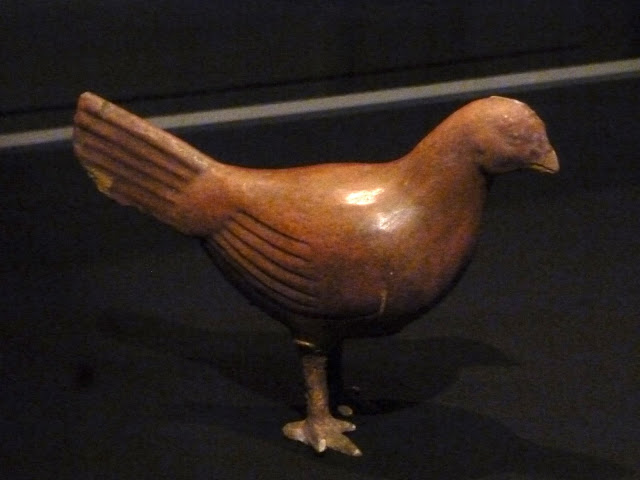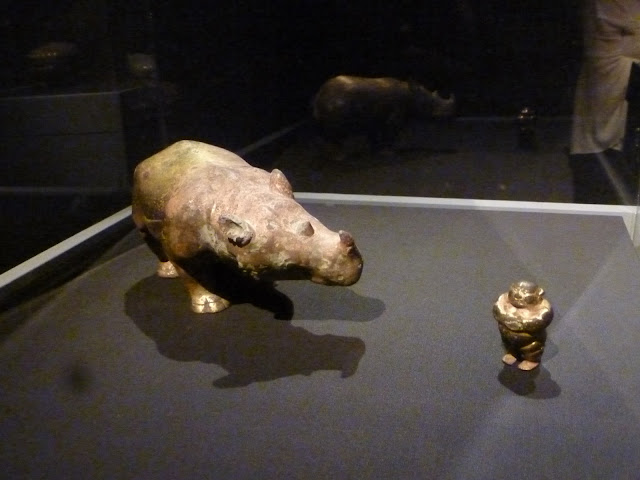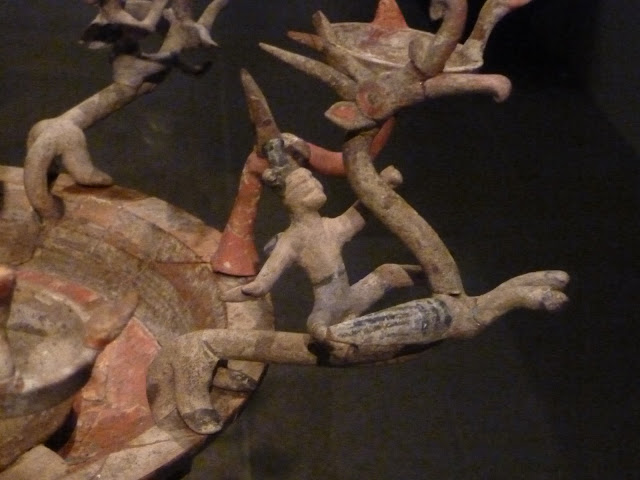As the USA consumed with internal conflicts gradually withdraws from the world stage, China the once and future world power, is best positioned to fill the power vacuum that will be left behind.
Awhile ago, I went to see the great show Qin and Han: The Age of Empires at the Metropolitan Museum, and I took my camera.
The show featured some spectacular antiquities from museums around China, some of which I was surprised were allowed to travel. Some of these things were well known to me, and I was grateful that I could see them in the original without traveling to China. A lot of others were completely new to me.
China was at the very beginning of its greatness in the two dynasties that unified the Chinese kingdoms and forged them into a single state. The patterns and traditions of Chinese history and culture begin with these two dynasties.
The show began with some spectacular artifacts from the immense and still largely unexcavated tomb of the Qin Emperor near Xian.
All of these photos are mine and are freely available unless otherwise indicated.
A bronze four horse chariot from the Emperor's tomb complex
A four horse covered imperial carriage in bronze.
Amazing detailing in the harnesses of these short legged Central Asia ponies.
The splendid bronze chariot and charioteer
The covered imperial carriage in bronze. The Qin Emperor died in such a carriage in 210 BCE while on tour in eastern China. Ironically, what killed him was the very elixir that was supposed to guarantee his immortality. On the advice of his physicians and astrologers, the Emperor ingested mercury as a potion for everlasting life. He died of acute mercury poisoning.
A magnificent terra cotta archer from an immense burial pit near the Emperor's tomb that contains a vast army all made out of terracotta.
Terracotta figures from the Emperor's vast tomb complex.
One of the thousands of soldiers found standing in formation buried in a huge pit near the Imperial tomb. Each one of those thousands of soldiers is carefully individualized.
The so-called "General" from the warriors. Whatever he was, he appears to be some kind of commanding officer.
Apparently a martial arts warrior
A suit of armor from the tomb all in stone. It's not clear to me if this was an actual suit of armor, or some kind of replica of a suit originally made from bronze or iron, remade in stone for funerary purposes.
Photo from here.
The famous burial pit of the Terracotta Warriors of the first Qin Emperor. This huge pit is but one part of an immense burial complex, a necropolis modeled on the Emperor's capital city with inner and outer walls. The whole complex is about 1and a half by almost 4 miles. The Terracotta Warriors is the only part of the tomb complex that is extensively excavated. There may be other such pits.
The Terrracotta Warriors group is an amazing work. A chronicle from the time claims that the construction of the tomb complex occupied the whole of the Qin Emperor's reign from his ascent to the throne of the Kingdom of Qin at the age of 13 to his death in 210 BCE at age 49, and that thousands of people were employed in its construction. Each of the warriors is life size. Every single one of these warriors would each have require a lot of firing. Firing an entire army of clay soldiers would have consumed prodigious amounts of fuel.
This huge ceramic army testifies to the military power that supported the Emperor's reign, and that made him the first Emperor of a unified China under a single integrated state. The size and splendor of his tomb -- one of the most spectacular in the world rivaled only by the Pyramids of Giza in Egypt -- bears witness to the beginnings of China as a major world power.Ying Zheng, the King of Qin, conquered the remaining states from the long period of division known as the Warring States Period. He used his superior military power and ability to subdue all the other states of China and destroy them. Ying Zheng was the first ruler of China to claim the title of Emperor. Previous rulers of China in the Shang and Zhou dynasties had the title of King. He took the name Qin Shi Huang that simply means the First Qin Emperor.
Photo from here.
This is the burial mound of the Qin Emperor in the center of his tomb complex. It remains unexcavated. Beneath this mound is the Underground Palace where the Emperor, his concubines, and several tomb workers lie buried. One of the most vivid passages the Records of the Grand Historian that documents the Emperor's reign is this description of his tomb:
In the ninth month, the First Emperor was interred at Mount Li. When the First Emperor first came to the throne, the digging and preparation work began at Mount Li. Later, when he had unified his empire, 700,000 men were sent there from all over his empire. They dug through three layers of groundwater, and poured in bronze for the outer coffin. Palaces and scenic towers for a hundred officials were constructed, and the tomb was filled with rare artifacts and wonderful treasure. Craftsmen were ordered to make crossbows and arrows primed to shoot at anyone who enters the tomb. Mercury was used to simulate the hundred rivers, the Yangtze and Yellow River, and the great sea, and set to flow mechanically. Above were representations of the heavenly constellations, below, the features of the land. Candles were made from fat of "man-fish", which is calculated to burn and not extinguish for a long time. The Second Emperor said: "It would be inappropriate for the concubines of the late emperor who have no sons to be out free", ordered that they should accompany the dead, and a great many died. After the burial, it was suggested that it would be a serious breach if the craftsmen who constructed the mechanical devices and knew of its treasures were to divulge those secrets. Therefore after the funeral ceremonies had completed and the treasures hidden away, the inner passageway was blocked, and the outer gate lowered, immediately trapping all the workers and craftsmen inside. None could escape. Trees and vegetations were then planted on the tomb mound such that it resembles a hill.
Recent surveys by scientific instruments indicate a very large structure at the heart of the tomb mound that is still intact. Chemical analyses show the presence of large amounts of metal, especially mercury in the mound, giving credence to the account in the Records of the Grand Historian. No one is quite sure what the "man fish" is described in this text.
The Qin Emperor consolidated his rule over all of China by a campaign of standardization: standardized weights and measures, a standard writing system, and even a standard size for wheel axles. He also brought the realm together through massive public works; an empire wide road network, a grand canal, and most famously, linking up the northern boundary walls of the former kingdoms into a single Great Wall of China. All of these measures would help secure the semi-divine imperial autocracy for centuries to come.
The Qin Emperor is also remembered for his cruelty and brutality, effectively enslaving the entire population to build these sprawling public works.
The remains of a terracotta strong man found in the Qin Emperor's tomb complex, part of a series of sculptures of entertainers and circus performers. This is a remarkable sculpture, anatomically detailed and accurate outside of the figurative traditions of either India or the West. The realism and the monumental grandeur of all of these figures from the Qin Emperor's tomb call to mind Rome or imperial Egypt more than what we usually associate with China. This appears to be a unique moment in Chinese art that was not repeated, at least not in sculpture.
The rest of the show is about the Han Dynasty that replaced the short lived Qin dynasty. The Qin Dynasty did not long outlive its first Emperor. The Second Emperor lasted barely 4 years before he fell in a peasant rebellion brought on the by the brutality of the Qin. One of the leaders of the rebellion, a soldier son of peasants named Liu Bang, became Gaozu, the first Han Emperor. The Han Dynasty would last another four centuries and be remembered by later historians as a golden age of imperial greatness. The Empire flourished with a booming economy in part driven by foreign trade. It was during the Han Dynasty that the Silk Road began through Central Asian territories subdued and pacified by the Han military. The Han Dynasty saw several major developments in science and technology; the invention of the firs seismograph, the use of paper, and the invention of negative numbers in mathematics.
These are figures from the tomb of the Emperor Jing Di. They are much smaller versions of the life sized terracotta soldiers made for the Qin Emperor. These too were soldiers and retainers. These figures once wore clothes and armor made specially for them. Some of that clothing remains on some of the figures.
As with the figures from the tomb of the Qin Emperor, so these from Emperor Jing Di's tomb are also very much individualized. They are not quite as grand and monumental as the ones made for the Qin Emperor. But, they have a certain sensitivity not seen in the Qin figures.
Soldiers in situ in the tomb complex of the Emperor Jing Di. Photo from here.
The tumulus of Emperor Jing Di. Photo from here.
Like the tumulus of the Qin Emperor, this mound remains unexcavated. The Chinese government opened only two imperial tombs: that of the Ming Emperor Wan Li, and that of the Penultimate Qing Emperor Guangxu. The official Chinese policy is to open no more imperial tombs unless there is a conservation emergency.
A terracotta dancing girl from a Han tomb.
Another dancing girl. This one in mid dance is a masterpiece of flowing form and rhythm.
A musician playing what appears to be a guqin.
A room full of Han Dynasty antiquities in bronze, terracotta, and lacquerware made for the tombs of provincial nobility.
A bronze hu
Detail of the bronze hu above; amazing gold inlay work.
A splendid lacquer wing cup in sterling condition from the tomb of Lady Dai at Mawangdui in Changsha.
Lacquerware bowls from the same tomb at Mawangdui.
An amazing lacquer serving tray from Mawangdui.
A lacquer ting from Mawangdui recalling similar ancient vessels made of bronze.
There was a room full of remarkable sculptures of animals from the Han Dynasty
Cattle
A wonderful pig.
Horses, all from that short legged Central Asian variety.
A rooster
A hen.
The label copy identified this as a dog. It looks more like some kind of monster to me.
A wonderfully expressive rhino
The rhino with a groom
A star of the whole show, the jade burial suit of the Princess Dou Wan theatrically displayed in typical Met Museum fashion.
Dou Wan was the wife of Liu Sheng, a son of the Emperor Jing Di given title over a fiefdom in the second century BCE. The Prince allegedly led a dissolute life with a little too much wine, women, and song that left him with 120 children.
Both the Prince and Princess were buried together in a single tomb, each in a jade burial suit. Until these suits were discovered in 1968, jade burial suits were thought to be another fabrication of exaggerating historians and chroniclers from later dynasties. Since this pair was discovered almost 50 years ago, more such jade burial suits have been found.
The workmanship in this burial suit is really amazing. Hours, days, and months were spent carving and polishing each single piece of jade for this suit. Every single piece was unique and a challenge to carve out of the hard stone; for example, look at all the work that went into the nose alone. Gold wire joins the pieces together.
One book of Chinese archaeology I have from the 1970s estimates that making this suit probably took 10 years of labor.
The point of the jade suit was to preserve the remains of the dead. This suit did not succeed very well in that task. Within the suit at its discovery were just a few bone fragments and some dust.
A Han Dynasty cowrie shell container from the south of China.
Very lively urban scene on the top showing very busy street life with a gilded Very Important Person carried on a litter.
Among the more spectacular objects in the exhibit was this elaborate bronze item known as a money tree because of the many coins embedded in it. There is another such tree in the Asian Museum in San Francisco, though it is not nearly as spectacular as this one.
This fantastic filigree object is full of coins and otherworldly creatures, especially a phoenix who adorns the top.
The amazing base of the money tree with its fantastic animals.
Another elaborate object is this terracotta lamp also elaborately adorned with otherworldly creatures.
A tomb model of a Han Dynasty fortified manor house.
A burial chamber portal adorned with scenes from a funerary feast.
The final object in this exhibition was this splendid bronze mirror.











































































No comments:
Post a Comment